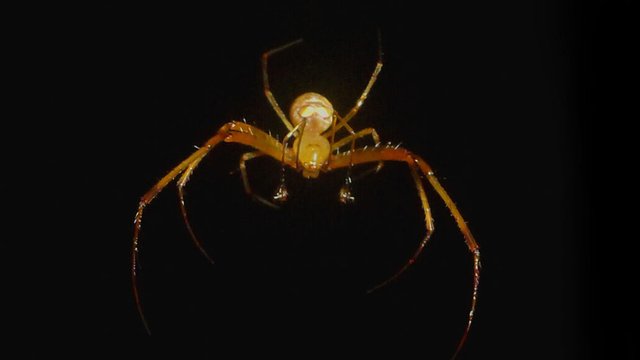A Costa Rican pirate spider lives up to the family name: It tricks closely related orb weaver spiders into “walking the plank,” right to their doom.

The world’s many pirate spiders exploit a very particular food source — other spiders. But while most pirate spiders invade the webs of other arachnids, Gelanor siquirres dupes potential prey into building a web right into a trap, researchers report in an upcoming Animal Behaviour.
Like any respectable pirate, pirate spiders have an extensive bag of tricks. Some species delicately strum the threads of other spiders’ webs to convince the arachnids they’ve caught an insect, only to strike when the web owner comes to collect its prey. Others mimic on a web the signature rhythms of a different spider’s courtship dance, luring would-be suitors to their deaths.
On a trip several years ago to a biological reserve in Costa Rica, researchers were the first to witness a hunt by a little-known species called G. siquirres. It cleverly exploits the way other spiders make their webs to get a meal, the team realized.
At nightfall in the steamy lowland rainforests of Costa Rica, orb weavers let loose “floating lines” — single strands of silk that blow in the breeze until the free end sticks on another surface, such as a tree branch. The orb weaver then scurries across to secure the second anchor point, and this first moored line serves as the foundation for the web.
But when G. siquirres strikes, the orb weaver does not scuttle across this bridge line to some welcoming vegetation. Instead, it walks into a trap; G. siquirres has already cast its own silk lines, not with the intention of building a web, but to intercept that of the orb weaver.
During their trip, arachnologist Laura Segura-Hernández and colleagues came upon a perplexing scene: An unusual configuration of multiple strands of silk converged at a single leaf. The group also noticed another spider’s floating line caught on one of those strands. Then, as the floating line’s owner — a juvenile orb weaver — scuttled across, a pirate spider emerged from behind its leaf hideout and crept down toward the intersection.
Probably feeling vibrations from the approaching pirate spider, the orb weaver attached a dragline — the arachnid’s version of a bungee cord — and flung itself off its bridge line. The pirate spider was close on its heels, pursuing from its own dragline.
“They’re hanging there, fighting,” says Segura-Hernández, who recently finished her Ph.D. at the University of Nebraska–Lincoln. It was a dramatic scene, she says, like two swashbuckling pirates exchanging blows while swinging from the rigging. The encounter ended with a surprisingly swift attack from the pirate that instantly immobilized its prey.
The hunting strategy comes as a total surprise, says Gustavo Hormiga, a biologist at George Washington University in Washington, D.C., who helped name and describe G. siquirres in 2016. Exploiting how other spiders build their webs is “actually pretty sophisticated,” he says. “I don’t know of anything like that in any [other] spider group.”
This new study helps bring G. siquirres to life, Hormiga says. Until now, the spider was known to science through only a dead specimen collected in 1994.
The finding also underscores the need for old-school natural historians, Hormiga says, the kind of scientists who wander out at night with a head lamp to see what there is to find. “For many of us, this is really what brought us into science,” he says. “Not pipetting. Just being out there.”
ok
Downvoting a post can decrease pending rewards and make it less visible. Common reasons:
Submit